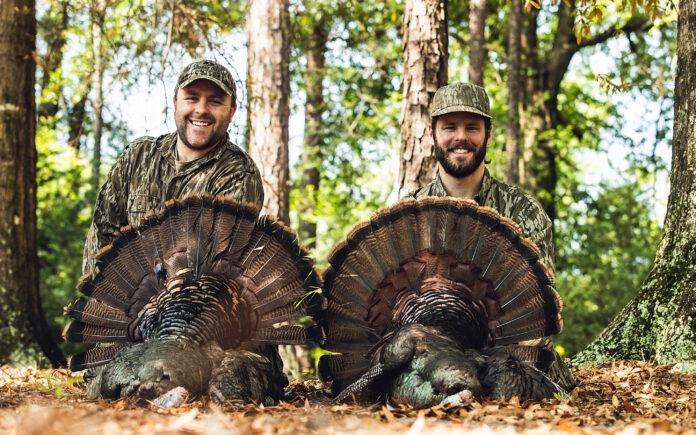
At the recent Alabama Conservation Advisory Board meeting in Montgomery, one of the people who took advantage of the opportunity to address the Board was David Hawley of Livingston, Alabama. At that meeting on March 6, the Board approved a motion to open the 2022 turkey season on March 25, with a four-bird season bag limit. Decoys would be prohibited the first 10 days of the season. The season length will remain 45 days in most of the state.
Hawley decided to speak at the meeting because of all the feedback he has received from the turkey hunting community, as well as what he has witnessed in west Alabama. Hawley works for Mossy Oak Properties and produces the Wild Turkey Report (www.wildturkeyreport.com).
Hawley’s talk was about his love for turkey hunting and his willingness to do whatever it takes to ensure the Eastern Wild Turkey continues to thrive in our state.
“I wanted to express my concerns with turkey populations,” he said. “I felt we, as a state, needed to make some changes that will benefit the long-term health of the turkey population. Time will tell whether the changes have an impact, but I do believe the later start date will give hens more time to breed. I believe the regulation regarding the decoys will protect some of the dominant turkeys during that first 10 days of the season.
“Reducing the bag limit may have some effect, but my main sentiment is that, in addition to the regulations, we as turkey hunters, landowners and conservationists need to understand our role of doing a better job of managing our habitat through prescribed fires, managing our predator populations and also being cognizant of our harvest decisions.”
Hawley killed his first turkey when he was 9, hunting with dad (Chris) in the Tombigbee River swamp. “That was the year I got hooked,” Hawley said of turkey hunting and turkey calling.
He became so proficient with a turkey call that he started entering contests and doing especially well, so well that he ended up in New York City on the David Letterman Show twice. Hawley had finished in the top five at the National Wild Turkey Federation (NWTF) Grand Nationals in the junior division both years and was invited on the show. He did a fly-down cackle one show and a fighting purr on the other.
His desire for competition calling waned later in his teenage years, but his passion for turkey hunting did not.
With the 2021 spring turkey season opening on March 20, Hawley is definitely in tune with what is happening in the turkey woods in west Alabama.
“As of today (March 10), turkeys are right on track in their breeding cycle,” he said. “I’ve heard some turkeys. They appear to be grouped up, as they should be. I think it’s right on schedule. Due to the habitat work and predator control efforts we have implemented on our farm, we had a decent hatch a couple of years ago. While our properties’ turkey numbers are off long-term, we should have a relatively stable amount of turkeys compared to the past several years, especially a few more 2 year-old gobblers. I saw a fair amount of jakes last year. But my concern is the inconsistencies I hear from throughout the state and when looking back at my hunting experiences the past five years.”
Of course, weather plays a significant role in turkey hunting and turkey production. A cold, wet spring reduces the chances of nesting success and poult survival, and the gobblers tend to be less vocal. Hopefully, the weather forecast for this spring is spot on.
“Based on the long-range forecast, it should be fairly warm and fairly dry, which is a great thing from a turkey standpoint,” Hawley said. “We need a dry spring. It will help with poult recruitment.”
Hawley considers patience a virtue through the season but especially early in the season.
“I’m looking for the opportunity to strike at the right time,” he said. “If I feel like a turkey is really henned up, I’m willing to wait a few days before I go back in and try him. Early season can have some tough hunting. We are stepping into the woods and assuming the role of a hen in the midst of dozens of real and receptive hens. This I why I don’t press the dominant gobbler and his harem as much as some do. I think my chances are greater in finding a subordinate gobbler or having one leave the flock.
“Several years ago, I roosted a big group of turkeys in a large agricultural field. The flock pitched down 200 yards away, and two gobblers strutted around the dozen or so hens. But one did not. Every time I yelped, the non-strutter would look up from his feeding. He finally broke away from the flock and came in.”
Hawley looks at the season as a whole as a marathon, not a sprint, and he tries to allow the turkeys to go through their natural progression through the season, adjusting his hunting techniques to the prevailing conditions.
“Now I’m going to be in the same vicinity and calling to them in case a sub-dominant gobbler decides to break off from the flock,” he said. “But I’m not going to put a lot of pressure on them early when I know they’re in these big groups.
“The woods are wide open early in the season. It’s really easy to bump turkeys. I try to lay back a little bit. But if you’re hunting a lease or public land, especially on just weekends, you may have to do it a lot differently than I am.”
Early in the season, Hawley’s calling tactics are also different. His focus is on the dominant hen.
“I try to get a boss hen fired up,” he said. “I’m going to try to mimic her the best I can with some excited calling, some flock talk and maybe some kee-kees (lost calls). I’m trying to play off the hen’s dominant nature to control that flock.
“If I hear jakes in there, I’m going to try to start calking (yelping) like a jake. It’s good to have jakes in the flock because of the gobblers’ competitive nature.”
As the season progresses more hens are bred and start to nest. The groups will split up. When that happens, the likelihood of encountering a lone gobbler is much better.
“That’s when I get really aggressive and try to cover a lot of ground,” Hawley said. “Basically, I’m trying to find the hottest turkey that I can. If it’s bad weather, I’m not going to push it unless he’s gobbling good.
“If it’s that window with good weather, I’m going to be aggressive. That last week in March is what I call kamikaze week, especially if you have a lot of 2-year-olds running together. They are not in the main group and have already bred a good many hens. That’s when you can get aggressive and strike turkeys up in the day.”
The 2021 turkey season runs March 20 through May 2 in Zone 1, which covers most of the state, with a five-bird season bag limit. Visit www.outdooralabama.com/seasons-and-bag-limits/turkey-season for details on the 2021 turkey season.
Leaving the next generation with a vibrant wild turkey population is more important to Hawley than walking out of the woods with a turkey on his shoulder.
“I enjoy hunting turkeys as much as anyone, but I have to realize that my pull of the trigger has to be met with a ten-fold response of giving back,” he said. “What really drives me is that my son and nephews get to experience the same things I did growing up. If I have to sacrifice a little in the short term, I’m more than willing to do that.
“We need to support the efforts of the state agencies, the biologists they work with for guidance, and conservation organizations financially and mirror their missions with boots on the ground and be a positive light for turkey hunting and conservation. It’s all about fair chase, respecting the birds and respecting our fellow hunters.”


























